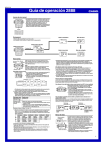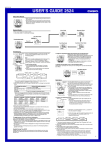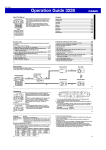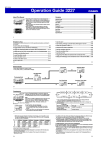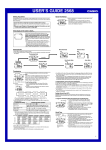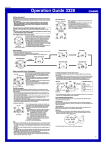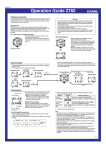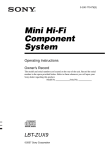Download Casio 2888 Watch User Manual
Transcript
MO0407-EA Operation Guide 2888 About This Manual • Button operations are indicated using the letters shown in the illustration. Keypad keys are indicated by their main keycap markings within square brackets in bold, such as [2]. • Each section of this manual provides you with the information you need to perform operations in each mode. Further details and technical information can be found in the “Reference” section. Keypad General Guide Calculator Mode Alarm Mode • Press B to change from mode to mode. • In any mode, press L to illuminate the display. ▲ ▲ Data Bank Mode Timekeeping Mode ▲ ▲ Stopwatch Mode Dual Time Mode ▲ ▲ Press B. Timekeeping Hour : Minutes Seconds Day of week Use the Timekeeping Mode to set the time and date. You can also view the Dual Time Mode screen or Data Bank Mode screen from the Timekeeping Mode. Note This watch is capable of displaying text for the day of the week in any one of 13 different languages (English, Portuguese, Spanish, French, Dutch, Danish, German, Italian, Swedish, Polish, Romanian, Turkish, and Russian). Year Month–Day PM indicator To set the time and date 1. In the Timekeeping Mode, hold down A until the seconds digits start to flash. This is the setting screen. 2. Use C and B to move the flashing in the sequence shown below to select other settings. Language indicator llll llll llll llll Press C. Seconds Press B. Year Minutes Month Hour Day Language • The currently selected language indicator flashes on the display while the Language setting is selected in the above sequence. 3. When the setting you want to change is flashing, use the keypad to change it as described below. • You must input two digits for the hour, minutes, year, month, and day settings. If you want to specify 3 o’clock, for example, input 03 for the hour. For the year setting, input the two rightmost digits. To do this: Reset the seconds to 00 Change the year, month, day, hour, or minutes Change the language Do this: Press [0]. Input values on the keypad keys. • The flashing moves to the right each time you input a value. • While the hour or minutes is flashing (12-hour timekeeping only), press [=PM] to toggle between AM (A indicator) and PM (P indicator). Use [+] and [÷]. • While the language indicator is flashing on the display, use [+] and [÷] to cycle through the language indicators as shown below until the one for the language you want to select is displayed. [+] Indicator Language Indicator Language Indicator Language ENx POR ESP FRA [÷] NED English Portuguese Spanish French Dutch DAN DEU ITA SVE POL Danish German Italian Swedish Polish RO T)R PUC To toggle between 12-hour and 24-hour timekeeping In the Timekeeping Mode, press C to toggle between 12-hour timekeeping (indicated by A or P on the display), or 24-hour timekeeping. • With the 12-hour format, the P (PM) indicator appears on the display for times in the range of noon to 11:59 p.m. and the A (AM) indicator appears for times in the range of midnight to 11:59 a.m. • With the 24-hour format, times are displayed in the range of 0:00 to 23:59, without any indicator. • The 12-hour/24-hour timekeeping format you select in the Timekeeping Mode is applied in all modes. Daylight Saving Time (DST) Daylight Saving Time (summer time) advances the time setting by one hour from Standard Time. Remember that not all countries or even local areas use Daylight Saving Time. To toggle the Timekeeping Mode time between DST and Standard Time Holding down C for about two seconds in the Timekeeping Mode toggles between Daylight Saving Time (DST displayed) and Standard Time (DST not displayed). • Note that pressing C in the Timekeeping Mode also toggles between 12-hour timekeeping and 24-hour timekeeping. • The DST indicator appears on the Timekeeping and Alarm Mode displays to indicate that Daylight Saving Time is turned on. To display the Dual Time screen and Data Bank screen in the Timekeeping Mode Holding down [÷] in the Timekeeping Mode displays the Dual Time screen. Holding down [+] displays the record you were viewing when you last used the Data Bank Mode. Hold down [÷] Dual Time Screen Data Bank Screen Data Bank Remaining number of records Name Romanian Turkish Russian 4. Press A to exit the setting screen. • The day of the week is automatically displayed in accordance with the date (year, month, and day) settings. • See the “Day of the Week List” for information on abbreviations used. • In addition to the day of the week display, the language setting also affects the type of characters you can input for the name in the Data Bank Mode. • Holding down A in the Timekeeping Mode displays the indicator for the currently selected language. Keeping A depressed for one second changes to the Timekeeping Mode setting screen (indicated by the flashing seconds digits). If you accidentally display the setting screen, press A again to exit. Hold down [+] Telephone number The Data Bank Mode lets you store up to 25 records, each containing name and telephone number data. Records are automatically sorted based on the characters of the name. You can recall records by scrolling through them on the display. • The characters you can input for the name depend on the language you select in the Timekeeping Mode. See “To set the time and date” for more information. Changing the language setting does not affect names that are already stored. • All of the operations in this section are performed in the Data Bank Mode, which you enter by pressing B. • Holding down [=PM] in the Data Bank Mode displays the number of remaining records. Creating a New Data Bank record When creating a new Data Bank record, you can input the name and then the telephone number, or you can input the telephone number and then the name. Being able to input the phone number first helps to avoid forgetting a number as you input the name. 1 Operation Guide 2888 Calculator || You can use the Calculator Mode to perform arithmetic calculations, as well as currency conversion calculations. You can also use the Calculator Mode to turn the input tone on and off. • All of the operations in this section are performed in the Calculator Mode, which you enter by pressing B. • Before starting a new calculation or currency conversion operation in the Calculator Mode, first use C to display one of the screens shown below. Press C. ▲ ▲ || To input the name and then the phone number of new Data Bank record 1. In the Data Bank Mode, press C to display the new Name area record screen. • The new record screen is the one that is blank (contains no name and telephone number). • If the new record screen does not appear when you press C, it means that memory is full. To store Number area another record, you will first have to delete some of New Record Screen the records stored in memory. 2. Hold down A until the flashing cursor (_) appears in | | | the name area of the display. This is the record input screen. Timekeeping Mode time Value input area || Calculator Screen (space) [÷] A to Z (alphabet) @ to (symbol) 0 to 9 (number) • The above character sequence is for English input. See “Character List” for the character sequences of other languages. 4. When the character you want is at the cursor position, press C to move the cursor to the right. 5. Repeat steps 3 and 4 until the name is complete. • You can input up to eight characters for the name. 6. After you input the name, press C as many times as necessary to move the cursor to the number area. • When the cursor is located at the eighth space of the name area, moving the cursor to the right causes it to jump to the first digit of the number. When the cursor is at the 15th digit of the number, moving it to the right (by pressing C) causes it to jump to the first character in the name. • Pressing C moves the cursor the right, while B moves it to the left. 7. In the number area, use the keypad to input the telephone number. • Each time you input a digit, the cursor automatically moves to the right. • The number area initially contains all hyphens. You can leave the hyphens or replace them with numbers or spaces. • Use [.SPC] to input a space and [–] to input a hyphen. • If you make a mistake while inputting numbers, use C and B to move the cursor to the location of the error and input the correct data. • You can input up to 15 digits for the number. 8. Press A to store your data and exit the Data Bank record input screen. • When you press A to store data, the name and number you input flash for about one second as Data Bank records are sorted. After the sort operation is complete, the Data Bank record screen appears. • The name can show only three characters at a time, so longer text scrolls continuously from right to left. The last character is indicated by the symbol s after it. lll lll To input the telephone number and then the name of new Data Bank record 1. In the Data Bank Mode, press C to display the new Name area record screen. 2. Use the keypad to input the telephone number. • Pressing a number key as the first input in a new Data Bank record will input the number at the first position of the number area, and automatically move the Number area cursor to the next position to the right. Input the rest of New Record Screen the phone number. • Use [.SPC] to input a space and [–] to input a hyphen. • If you make a mistake while inputting the phone ll l number, press C. This will return to the blank new record screen, so you can restart your input. lll • If you do not input anything for about two or three minutes, or if you press B, the watch will exit the input screen and change to the Timekeeping Mode. Anything you have input up to that point will be cleared. 3. After inputting the telephone number, hold down A until the flashing cursor (_) appears in the name area of the display. This is the record input screen. 4. Input the name that goes with the number. • Use [+] and [÷] to cycle through the characters at the cursor position. Use C and B to move the cursor. For details about character input, see steps 3 through 5 under “To input the name and then the phone number of new Data Bank record”. 5. After inputting the name, press A to store your data and exit the Data Bank record input screen. To recall Data Bank records In the Data Bank Mode, use [+] (+) and [÷] (–) to scroll through Data Bank records on the display. • See “Sort Table” for details on how the watch sorts records. • Pressing [+] while the last Data Bank record is on the display displays the new record screen. To delete a Data Bank record 1. In the Data Bank Mode, use [+] (+) and [÷] (–) to scroll through the records and display the one you want to delete. 2. Hold down A until the flashing cursor appears on the display. This is the record input screen. 3. Press B and C at the same time to delete the record. • CLR appears to indicate that the record is being deleted. After the record is deleted, the cursor appears on the display, ready for input. 4. Input data or press A to return to the Data Bank record screen. Performing Arithmetic Calculations You can perform the following types of arithmetic calculations in the Calculator Mode: addition, subtraction, multiplication, division, arithmetic constants, powers, and approximate values. To perform arithmetic calculations When the calculator screen is displayed in the Calculator Operator area Mode, you can use the keypad to input calculations just as Operator symbol you do with any standard calculator. See the examples below for details. • Be sure to press C to clear the arithmetic calculator screen to zero before beginning each calculation. If the screen is already cleared, pressing C will switch to the currency converter screen. Value input area • While you are inputting a calculation, values are displayed in the value input area, and operators are displayed in the operator area of the display. Example Display Operation (Basic Calculation) 12.3 + 74 - 90 = -3.7 [1] [2] [.SPC] [3] [+] [7] [4][–] [9] [0] [=PM] (12 - 0.5) × 3 ÷ 7 =4.9285714 ×] [3] [÷] [7] [=PM] [1] [2] [–] [.SPC] [5] [× x3 & 4 9285&14 (Constant Calculation) 10 + 7 = 17 12 + 7 = 19 [7] [+] [+] [1] [0] [=PM] [1] [2] [=PM] +K +K (2.3)4 = 27.9841 ×] [× ×] [=PM] [=PM] [=PM] [2] [.SPC] [3] [× XK 1& 19 2& 9841 • To perform a constant calculation, input the value you want to use as a constant and then press one of the arithmetic operator keys twice. This makes the value you input a constant, which is indicated by the n indicator next to the operator symbol. • An E (error) indicator will appear whenever the result of a calculation exceeds 8 digits. Press C to clear the error indicator. After that, you will be able to continue the calculation using an approximate result. • The following table describes how to correct input errors and how to clear the calculator after you finish using it. When you need to do this: Correct or change the value you are currently inputting, without deleting the part of the calculation you have input up to the current value Correct or change the arithmetic operator (+, –, ×, ÷) you have just input Completely clear the calculation you are inputting Clear a displayed calculation result (produced by pressing the [+], [–], ×], [÷], or [=PM] key) and its [× calculation Perform this key operation: Press C to clear the displayed value and return to the 0 display. Next, input the value you want. Without pressing C, press the key for the correct arithmetic operator. Press C to clear the displayed value and return to the 0 display. Next, press C again. Press C. Currency Conversion Calculations You can register a single currency exchange rate for quick and easy conversion to another currency. • The default conversion rate is × 0 (multiply the input value by 0). × represents the multiplication operator and 0 is the exchange rate. Be sure to change the value to the exchange rate value and the operator (multiplication or division) you want to use. To change the exchange rate and the operator 1. While the currency converter screen is displayed in the Operator symbol Calculator Mode, hold down A until the exchange rate starts to flash on the display. This is the setting screen. l lll 2. Use the keypad to input the exchange rate and the ×]or [÷]) you want to use. operator ([× • To clear the displayed exchange rate to zero, press C. Exchange rate 3. Press A to exit the setting screen. lll To edit a Data Bank record 1. In the Data Bank Mode, use [+] (+) and [÷] (–) to scroll through the records and display the one you want to edit. 2. Hold down A until the flashing cursor appears on the display. This is the record input screen. 3. Use C (right) and B (left) to move the flashing to the character you want to change. 4. Use the keypad to change the character. • For details about character input, see steps 3 (name input) and 7 (number input) under “To input the name and then the phone number of new Data Bank record”. 5. After making the changes that you want, press A to store them and exit the Data Bank record input screen. How the C button affects the current screen in the Calculator Mode • Pressing C while the current screen (arithmetic calculator or currency converter screen) shows a value other than zero will clear the screen to zero, without changing to the other screen. • Pressing C while an E (error) indicator is displayed clears the E (error) indicator, but does not clear the current calculation to zero. • Pressing C while the current screen (arithmetic calculator or currency converter screen) is cleared to zero, will switch to the other screen. llll [+] Currency Converter Screen • Arithmetic and currency conversion calculation input and result values can be up to eight digits for positive values, and seven digits for negative values. • Exiting the Calculator Mode causes all currently displayed values to be cleared. llll 3. In the name area, use [+] and [÷] to cycle through characters at the cursor position. The characters cycle in the sequence shown below. To check the current exchange rate and operator setting 1. While the currency converter screen is displayed in the Calculator Mode, hold down A until the exchange rate starts to flash on the display. This is the setting screen. • The setting screen will also show the current exchange rate and operator setting. 2. Press A to exit the setting screen. 2 Operation Guide 2888 To perform a currency conversion calculation 1. While the currency converter screen is displayed in the Calculator Mode, use the keypad to input the value from which you want to convert. 2. Press [=PM] to display the conversion result. 3. Press C to clear the conversion result. • An E (error) indicator appears on the display when the result of a calculation exceeds 8 digits. Press C to clear the error indicator. • Pressing [=PM] while a calculation result is displayed will apply the conversion rate again to the displayed value. Turning the Input Tone On and Off An input tone causes the watch to beep each time you press a button or keypad key. You can turn off the input tone if you want. • The input tone on/off setting you select in the Calculator Mode is applied to all other modes, except the Stopwatch Mode. • Note that alarms will continue to sound even if the input tone is turned off. To turn the input tone on and off While the calculator screen or currency converter screen MUTE indicator is displayed in the Calculator Mode, hold down C for about two seconds to toggle the input tone on (MUTE indicator not displayed) and off (MUTE indicator displayed). • Holding down C will also switch the Calculator Mode screen. • The MUTE indicator is displayed in all modes when the input tone is turned off. Alarms Alarm number Alarm time Timekeeping Mode time Alarm date Alarm Screen You can set up to five independent multi-function alarms with hour, minutes, month, and day. When an alarm is turned on, the alarm tone sounds when the alarm time is reached. One of the alarms can be configured as a snooze alarm or a one-time alarm, while the other four are one-time alarms. You can also turn on an Hourly Time Signal, which will cause the watch to beep twice every hour on the hour. • There are five alarm screens numbered 1 through 5. The Hourly Time Signal screen is indicated by :00. • All of the operations in this section are performed in the Alarm Mode, which you enter by pressing B. Alarm Operation The alarm tone sounds at the preset time for 10 seconds, regardless of the mode the watch is in. In the case of the snooze alarm, the alarm tone operation is performed a total of seven times, every five minutes, until you turn the alarm off or change it to a one-time alarm. • Pressing any button or key stops the alarm tone operation. • Performing any one of the following operations during a 5-minute interval between snooze alarms cancels the current snooze alarm operation. Displaying the Timekeeping Mode setting screen Displaying the alarm 1 setting screen To test the alarm In the Alarm Mode, hold down C to sound the alarm. • Pressing C also toggles the currently display alarm or the Hourly Time Signal on and off. To turn alarms 2 through 5 and the Hourly Time Signal on and off 1. In the Alarm Mode, use [+] and [÷] to select a onetime alarm (alarms 2 through 5) or the Hourly Time Hourly time signal Signal. on indicator 2. Press C to toggle it on and off. • The current on/off status of alarms 2 through 5 is shown by indicators along the bottom of the displays (al-2 through al-5). The SIG indicator shows the on (SIG displayed)/off (SIG not displayed) status of the Hourly Time Signal. Alarm 2 on Alarm 4 on • The alarm on indicators and Hourly Time Signal on indicator indicator indicator are displayed in all modes. • While an alarm is sounding, the applicable alarm on indicator flashes on the display. To select the operation of alarm 1 1. In the Alarm Mode, use [+] and [÷] to select alarm 1. 2. Press C to cycle through the available settings in the sequence shown below. SNZ indicator and alarm 1 on indicator Press C. SNZ al-1 SNZ indicator Alarm 1 on indicator Hourly Time Signal Screen Timekeeping Mode time Seconds Hours Press [+] AM indicator Hour : Minutes lllll lll lll l ll lll Month – Day Press [÷] x1 x2 x3 :00 x5 x4 • You can configure alarm 1 as a snooze alarm or a one-time alarm. Alarms 2 through 5 can be used as one-time alarms only. • The snooze alarm repeats every five minutes. 2. After you select an alarm, hold down A until the left hour setting of the alarm time starts to flash, which indicates the setting screen. • This operation automatically turns on the alarm. 3. Use the keypad to input the alarm time and date. • The flashing automatically advances to the right each time you input a number. You can also use B and C to move the flashing between input digits. • To set an alarm that does not use a month and/or day setting, input 00 for each of the unused settings. • If you are using 12-hour timekeeping, press [=PM] while the hour or minute setting is flashing to toggle between AM and PM. • When setting the alarm time using the 12-hour format, take care to set the time correctly as am (A indicator) or pm (P indicator). 4. Press A to exit the setting screen. • Note that the month and day setting each appear as 00 on the setting screen when no month or day is set. On the alarm screen, however, an unset month is shown as x and an unset day is shown as xx. See the sample displays under “To set an alarm time”. The stopwatch lets you measure elapsed time, split times, and two finishes. • The display range of the stopwatch is 23 hours, 59 minutes, 59.99 seconds. • The stopwatch continues to run, restarting from zero after it reaches its limit, until you stop it. • The elapsed time measurement operation continues even if you exit the Stopwatch Mode. • Exiting the Stopwatch Mode while a split time is frozen on the display clears the split time and returns to elapsed time measurement. • All of the operations in this section are performed in the Stopwatch Mode, which you enter by pressing B. Minutes 1/100 second To set an alarm time Alarm number One-time alarm on Stopwatch Note The 12-hour/24-hour format of the alarm time matches the format you select in the Timekeeping Mode. 1. In the Alarm Mode, use [+] and [÷] to scroll through the alarm screens until the one whose time you want to set is displayed. al-1 Alarm off • The SNZ indicator and alarm 1 on indicator (al-1) are displayed in all modes. • The SNZ indicator flashes during the 5-minute intervals between alarms. • The alarm indicator (al-1 and/or SNZ) flashes while the alarm is sounding. Alarm Types The alarm type is determined by the settings you make, as described below. • Daily alarm Set the hour and minutes for the alarm time. This type of setting causes the alarm to sound everyday at the time you set. • Date alarm Set the month, day, hour and minutes for the alarm time. This type of setting causes the alarm to sound at the specific time, on the specific date you set. • 1-Month alarm Set the month, hour and minutes for the alarm time. This type of setting causes the alarm to sound everyday at the time you set, only during the month you set. • Monthly alarm Set the day, hour and minutes for the alarm time. This type of setting causes the alarm to sound every month at the time you set, on the day you set. Snooze alarm on To measure times with the stopwatch Elapsed Time C Start Split Time C Start ➤C Stop ➤C Re-start ➤C Stop ➤A Clear ➤A Split ➤A Split release ➤C Stop ➤A Clear ➤C Stop ➤A ➤A (SPL displayed) Two Finishes C Start ➤A Split First runner finishes. Display time of first runner. Second runner finishes. Split release Clear Display time of second runner. 3 Operation Guide 2888 Dual Time Reference Dual time (Hour : Minutes Seconds) Timekeeping Mode time The Dual Time Mode lets you keep track of time in a different time zone. You can select Standard Time or Daylight Saving Time for the Dual Time Mode time, and a simple operation lets you view the Timekeeping Mode or Data Bank Mode screen. • The seconds count of the Dual Time is synchronized with the seconds count of the Timekeeping Mode. • All of the operations in this section are performed in the Dual Time Mode, which you enter by pressing B. This section contains more detailed and technical information about watch operation. It also contains important precautions and notes about the various features and functions of this watch. Auto Display Auto Display continually changes the contents of the digital display. To turn off Auto Display Press A, B, or C to turn off Auto Display. This returns to the Timekeeping Mode. To set the Dual Time 1. In the Dual Time Mode, hold down A until the left hour setting start to flash, which indicates the setting screen. 2. Use the keypad to input the dual time. • The flashing automatically advances to the right each time you input a number. You can also use B and C to move the flashing between input digits. • If you are using the 12-hour timekeeping format, press [=PM] to toggle between AM and PM. 3. Press A to exit the setting screen. ll l l ll lllll llll lll To toggle Dual Time Mode time between DST and Standard Time Holding down C for about two seconds in the Dual Time Mode toggles between Daylight Saving Time (DST displayed) and Standard Time (DST not displayed). • The DST indicator on the display indicates that Daylight Saving Time is turned on. To turn on Auto Display Hold down B for about two seconds until the watch beeps. • Note that Auto Display cannot be performed while a setting screen is on the display. Auto Return Features • The watch automatically returns to the Timekeeping Mode if you do not perform any operation under the conditions described below. – For two or three minutes in the Data Bank or Alarm Mode – For six or seven minutes in the Calculator Mode • If you do not perform any operation for two or three minutes while a setting or input screen (one with flashing digits or a cursor) is displayed, the watch will automatically exit the setting or input screen. • After you perform any button or key operation (except for L) in any mode, pressing B returns directly to the Timekeeping Mode. Scrolling To display the Timekeeping screen and Data Bank screen in the Dual Time Mode Holding down [÷] in the Dual Time Mode displays the Timekeeping screen. Holding down [+] displays the record you were viewing when you last used the Data Bank Mode. Hold down [÷] Hold down [+] The B and C buttons, and [+] and [÷] keys are used in various modes and setting screens to scroll through data on the display. In most cases, holding down these buttons during a scroll operation scrolls through the data at high speed. Initial Screens When you enter the Data Bank, Calculator, or Alarm Mode, the data you were viewing when you last exited the mode appears first. Timekeeping Timekeeping Screen Data Bank Screen Illumination Auto light switch on indicator The display of the watch is illuminated by an LED (lightemitting diode) and a light guide panel for easy reading in the dark. The watch’s auto light switch automatically turns on illumination when you angle the watch towards your face. • The auto light switch must be turned on (indicated by the auto light switch on indicator) for it to operate. • You can specify 1.5 seconds or 3 seconds as the illumination duration. • See “Illumination Precautions” for other important information about using illumination. To turn on illumination manually In any mode, press L to illuminate the display. • The above operation turns on illumination regardless of the current auto light switch setting. • Resetting the seconds to 00 while the current count is in the range of 30 to 59 causes the minutes to be increased by 1. In the range of 00 to 29, the seconds are reset to 00 without changing the minutes. • The year can be set in the range of 2000 to 2099. • The watch’s built-in full automatic calendar makes allowances for different month lengths and leap years. Once you set the date, there should be no reason to change it except after you have the watch’s battery replaced. Illumination Precautions • • • • Keypad keys are disabled and do not input anything while the display is illuminated. Illumination may be hard to see when viewed under direct sunlight. Illumination automatically turns off whenever an alarm sounds. Frequent use of illumination shortens the battery life. Auto light switch precautions • Wearing the watch on the inside of your wrist and movement or vibration of your arm can cause the auto light switch to activate and illuminate the display. To avoid running down the battery, turn off the auto light switch whenever engaging in activities that might cause frequent illumination of the display. • Illumination may not turn on if the face of the watch is more than 15 degrees above or below parallel. Make sure that the back of your hand is parallel to the ground. • Illumination turns off after the preset illumination duration (see “To specify the illumination duration”), even if you keep the watch pointed towards your face. More than 15 degree too high About the Auto Light Switch Turning on the auto light switch causes illumination to turn on, whenever you position your wrist as described below in any mode. Moving the watch to a position that is parallel to the ground and then tilting it towards you more than 40 degrees causes illumination to turn on. • Wear the watch on the outside of your wist. Parallel to ground More than 40° Warning! • Always make sure you are in a safe place whenever you are reading the display of the watch using the auto light switch. Be especially careful when running or engaged in any other activity that can result in accident or injury. Also take care that sudden illumination by the auto light switch does not startle or distract others around you. • When you are wearing the watch, make sure that its auto light switch is turned off before riding on a bicycle or operating a motorcycle or any other motor vehicle. Sudden and unintended operation of the auto light switch can create a distraction, which can result in a traffic accident and serious personal injury. To turn the auto light switch on and off In the Timekeeping Mode, hold down L for about two seconds to toggle the auto light switch on (auto light switch on indicator displayed) and off (auto light switch on indicator not displayed). • In order to protect against runnning down the battery, the auto light switch will turn off automatically approximately six hours after you turn it on. Repeat the above procedure to turn the auto light switch back on if you want. • The auto light switch on indicator is on the display in all modes while the auto light switch is turned on. llll Day of the Week List ENx POR ESP FRA NED DAN DEU ITA SVE POL ROo TgR RUS Sunday SUN DOo DOo DIo ZON SvN SON DOo SiN NIE DUo PAZ CS Monday Tuesday Wednesday Thursday oON TUE WED THU SEx TER QUA QUI LUN oAR oIb JUE LUN oAR oER JEU oAA DIN WOE DON oAN TIR ONS TOR oON DIE oIT DON LUN oAR oER xIO owN TIS ONS TOR PON WTO qRO CZW LUN oAR oIE JOI PZT SAL mAR PER QO BT SR YT Friday FRI SEX VIE VEN VRI FRE FRE VEN FRE PIl VIN CUo QT Saturday SAT SaB SaB SAo ZAT LvR SAo SAB LiR SOB Sjo CTS SB llll To specify the illumination duration 1. In the Timekeeping Mode, hold down A until the seconds start to flash, which indicates the setting 3 sec. indicator screen. 2. Press L to toggle the illumination duration setting between 3 seconds (3 sec. indicator displayed) and 1.5 ll seconds (3 sec. indicator not displayed). 3. Press A to exit the setting screen. • The 3 sec. indicator is displayed in all modes when the illumination duration setting is three seconds. • Static electricity or magnetic force can interfere with proper operation of the auto light switch. If illumination does not turn on, try moving the watch back to the starting position (parallel with the ground) and then tilt it back toward you again. If this does not work, drop your arm all the way down so it hangs at your side, and then bring it back up again. • Under certain conditions, illumination does not turn on until about one second after you turn the face of the watch towards you. This does not indicate malfunction. • You may notice a very faint clicking sound coming from the watch when it is shaken back and forth. This sound is caused by mechanical operation of the auto light switch, and does not indicate a problem with the watch. lll 4 Operation Guide 2888 Character List ENx: (space) A B C D E F x H I J n L o N O P Q R S T U V W X Y Z @ ] ?'.:/+-0123p56q89 POR: (espaço) A ; ( , h B C ^ D E = [ F x H I > J n L o N O ? ] i P QRSTU@VWXYZ@]?'.:/+-0123p56q89 ESP: (espacio) A ; B C D E = F x H I > J n L o N ` O ? P Q R S T U @ )VWXYZ@]?'.:/+-0123p56q89 FRA: (espace) A ( , B C ^ D E = a [ c F x H I e d J n L o N O ] g P Q RSTUbf)VWXYZ@]?'.:/+-0123p56q89 NED: (Spatie) A B C D E F x H I J n L o N O P Q R S T U V W X Y Z @ ]?'.:/+-0123p56q89 DAN: (Mellemsrum) A B C D E F x H I J n L o N O P Q R S T U V W X Y Zuvw@]?'.:/+-0123p56q89 DEU: (Leerzeichen) A h B C D E F x H I J n L o N O i P Q R S T U ) V WXYZ@]?'.:/+-0123p56q89 ITA: (spazio) A ( B C D E = a F x H I j e J n L o N O ? k P Q R S T UbVWXYZ@]?'.:/+-0123p56q89 SVE: (Mellanslag) A B C D E F x H I J n L o N O P Q R S T U V W X Y Z whi@]?'.:/+-0123p56q89 POL: (epacja) A l B C m D E n F x H I J n L o o N p O ? P Q R S q T UVWXYZrs@]?'.:/+-0123p56q89 ROo: (spa iu) A r , B C D E F x H I e J n L o N O P Q R S s T t U V W XYZ@]?'.:/+-0123p56q89 T)R: (bo luk) A B C ^ D E F x y H I t J n L o N O i P Q R S s T U ) VWXYZ@]?'.:/+-0123p56q89 PUC: (npo en) A B C D E F G * I J K L M o O P Q R S T U V W X Y bciefh@]?'.:/+-0123p56q89 a Sort Table 1 (space) 13 2 A 14 3 a 15 4 f 16 5 r 17 6 j 18 7 h 19 8 h 20 9 l 21 10 B 22 11 C 23 12 m 24 m D E b a [ c n F x y H 25 26 27 28 29 30 31 32 33 34 35 36 I > j e d t J n L o o N 37 38 39 40 41 42 43 44 45 46 47 48 p ` O ? k l i + g P Q R 49 50 51 52 53 54 55 56 57 58 59 60 S q s T t U @ b f ) V W 61 62 63 64 65 66 67 68 69 70 71 72 X Y Z r s u v w h i B C 73 74 75 76 77 78 79 80 81 82 83 84 D E F c * I J K L M o O 85 86 87 88 89 90 P Q R S T U 91 92 93 94 95 96 V W X Y a 97 98 99 100 101 102 b c i e f h 103 104 105 106 107 108 @ ] ? ' . : 109 110 111 112 113 114 / + 0 1 2 115 116 117 118 119 120 3 p 5 6 q 8 121 9 • Character 7 ( h) is for German, character 69 ( h) is for Swedish. • Character 43 ( i) is for German and Turkish, character 70 ( i) is for Swedish. • Characters 71 through 102 are for Russian. 5





